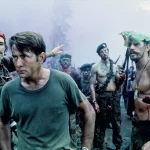Doctor Strange: How I Learned to Stop Worrying and Love the Origin Story, by Ian Brill
Earlier this year, Marvel Studios gave us what is arguably their most ambitious film ever. Captain America: Civil War built on almost every previous Marvel film to tell a story filled to the brim with superheroes. Doctor Strange, Marvel’s second offering for 2016, at first seems to give us something of a breather by returning to the familiar structure of an origin story. But with its commitment to novel visuals and complex supporting characters, this may be the most ambitious superhero film of the year.
While the film reaches bizarre heights, director and co-writer Scott Derrickson at first eases the audience into the story by giving them the touchstones they usually get in modern superhero films. Benedict Cumberbatch is Dr. Stephen Strange, a brilliant but arrogant surgeon. Derrickson emphasizes the brilliance far more than the arrogance, lest our protagonist seems unlikeable. Cumberbatch’s Strange is the type of cocky knave we have become accustomed to seeing on television. No one will blame audiences for comparing Cumberbatch’s performance to Hugh Laurie’s Dr. House, and not just because both are examples of English actors utilizing an American accent with sharp vowels and a nasal tone. The other clear comparison is Robert Downey Jr.’s portrayal of Tony Stark. The similarities are most apparent in Strange’s scenes with Rachel McAdams’ Christine Palmer. McAdams plays the long-suffering “will they/won’t they” love interest, not unlike the relationship between Downey’s Stark and Gwyneth Paltrow’s Pepper Potts. But Palmer seems to have less agency than Potts, and spends most of the film either listening to or being ignored by Strange (and hardly ever interacts with any other characters). As clever as Doctor Strange is, nothing is done with this tired trope and sadly, McAdams becomes yet another talented actress given a role in a major blockbuster that’s far below where her abilities can reach.
Strange soon gets into a terrible car crash, the result of his devil-may-care lifestyle. He survives but his hands suffer tremendous nerve damage. It looks like he’ll never be able to hold a scalpel again. When he exhausts all the options available from traditional medicine, he takes off to the East after learning of a healer located in Nepal that can do the impossible. Strange meets this healer, known only as The Ancient One, played by Tilda Swinton, and her pupil Karl Mordo, played by Chiwetel Ejiofor. Strange must humble himself to learn at the feet of The Ancient One, and it is here that Derrickson and his visual effects team get to show off their stuff. The Ancient One challenges Strange’s skepticism by giving him a glimpse of the other dimensions that exist with our own. The Doctor Strange comics drawn by Steve Ditko became a hit with the youth in the 60s, thanks to the vast psychedelic landscapes he illustrated. Here, the effect come full circle. The echoing images and colorful blurs are probably the most psychedelic images seen in any superhero film, right down to the homage to Stanley Kubrick’s 2001: A Space Odyssey.
The middle of the film follows the recognizable hero’s journey, with The Ancient One playing a role similar to Morpheus in The Matrix or Yoda in The Empire Strikes Back. The noticeable difference is that Strange is older and more accomplished than the usual film protagonists who undergo this process. Indeed, Cumberbatch never loses the arrogant streak he infused in Strange. It’s that confidence that prevents the character from being the kind of empty vessel true-blue film heroes often are. The old dog learns new tricks, such as how to make a gateway that take you to Mount Everest and back, but it’s soon clear there is a deeply formed personality here that simply isn’t going to go away.
All these elements come to a head in the second half of the film, when the villain Kaecilius, played by Mads Mikkelsen, faces off against Strange. All the information we learn about magic during Strange’s training sessions pays off and the story improves by leaps and bounds. Strange learns that he is caught between different ways to apply magic, and that there have been secrets kept from him. The villains’ methods are brutal, but their point-of-view has some validation, and even more so their criticism of The Ancient One. Kaecilius has the ability to twist and shape the any environment he’s in. From a story perspective, Derrickson twists the characters against each other in a way that allows Cumberbatch, Ejiofor, and Swinton to reveal the depths of their characters.
Leading into the film’s climax, Swinton gets a monologue that combines the major themes of the story. It’s the most triumphant piece of performance in the film. It displays all the wisdom but also humor and wonder Swinton gives a character who could have just been a cliché. It’s a key scene that displays how Doctor Strange rises above the norm.
Derrickson is able to build upon each set piece by never running out of inventive visuals. While he employs techniques that seem inspired by The Wachowskis’ The Matrix or Christopher Nolan’s Inception, Derrickson evolves those techniques by portraying sustained physical sequences that retain an internal logic. The inventiveness tops itself when Doctor Strange brings us one of the best endings in any Marvel film. It’s a sequence that relies on brains rather than brawn. In this climactic moment, the arrogance that Cumberbatch plays evolves into something heroic and self-sacrificing while also unafraid of being comedic.
While the character of Doctor Strange finds that there is more to this world than what the mortal senses can perceive, the film Doctor Strange proves there are more places the superhero origin story can go than what we have seen so far.





























